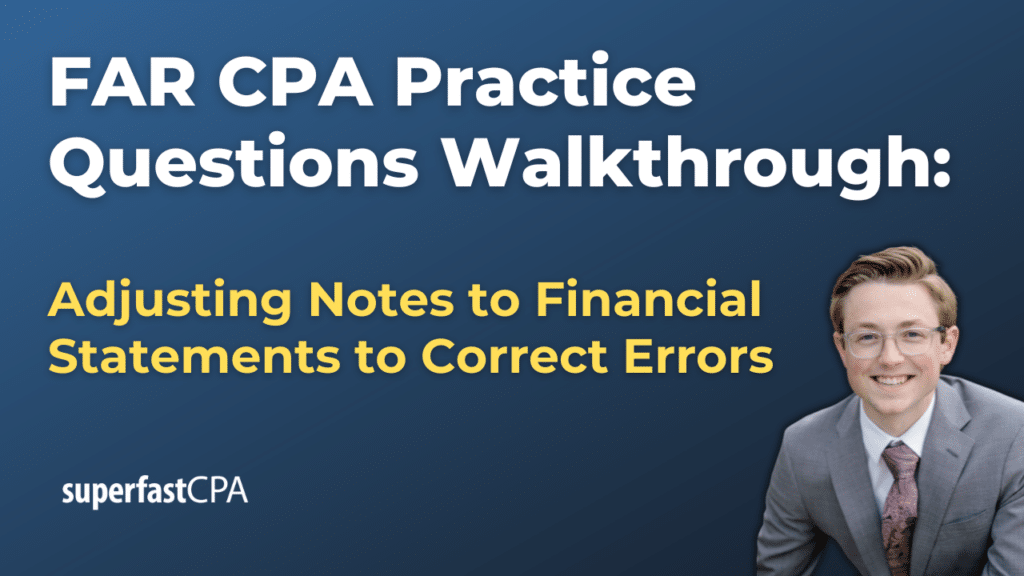In this video, we walk through 5 FAR practice questions teaching about adjusting notes to financial statements to correct errors. These questions are from FAR content area 1 on the AICPA CPA exam blueprints: Financial Reporting.
The best way to use this video is to pause each time we get to a new question in the video, and then make your own attempt at the question before watching us go through it.
Also be sure to watch one of our free webinars on the 6 “key ingredients” to an extremely effective & efficient CPA study process here…
Adjusting Notes to Financial Statements to Correct Errors
Introduction to Notes to the Financial Statements
Notes to financial statements are a crucial component of a company’s financial reporting. They provide additional context, detail, and explanation to the figures presented in the primary financial statements, such as the balance sheet, income statement, and cash flow statement. The notes help stakeholders—such as investors, creditors, analysts, and regulators—better understand the financial position, performance, and changes in the financial position of the company.
The notes typically include a variety of disclosures, such as:
- Significant Accounting Policies: This section outlines the principles, bases, conventions, rules, and practices applied by the company in preparing and presenting its financial statements. Key policies include methods for recognizing revenue, valuing inventory, depreciating assets, and determining cash equivalents.
- Detailed Breakdowns of Financial Statement Items: The notes provide detailed information about specific line items in the financial statements. For example, they might break down inventory by category, provide schedules of fixed assets and their depreciation, or detail the composition of equity.
- Contingencies and Commitments: These disclosures include information about potential liabilities or obligations that are reasonably possible to occur in the near future, such as pending lawsuits, guarantees, or lease commitments.
- Related Party Transactions: Notes disclose any transactions between the company and its related parties, which could include subsidiaries, affiliates, or key management personnel. This transparency is vital for assessing the fairness of the financial statements.
- Significant Estimates and Judgments: The notes explain significant estimates and judgments made by management, such as determining the allowance for doubtful accounts, estimating warranty liabilities, or assessing the recoverability of deferred tax assets.
- Concentration Risks: The notes disclose vulnerabilities due to concentrations, such as a significant portion of revenue coming from a small number of customers or a heavy reliance on a single supplier. These disclosures help stakeholders assess the risk profile of the company.
- Subsequent Events: Any significant events occurring after the balance sheet date but before the financial statements are issued are disclosed here, especially if they impact the financial statements.
Adjusting Notes to Correct Errors
Errors in the notes to financial statements can occur for various reasons, including oversight, misinterpretation of accounting standards, or simple clerical mistakes. When errors are identified, it is essential to correct them to maintain the integrity and accuracy of the financial reporting:
- Identify the Error: Determine whether the error is due to omitted information, incorrect details, or inappropriate inclusion of non-relevant information. Common errors include failing to disclose significant estimates, not providing enough detail on contingencies, or mistakenly including operational information irrelevant to the financial statements.
- Avoid Duplication: Ensure that information is not unnecessarily duplicated across different sections of the notes. Each piece of information should be presented clearly and concisely in its appropriate section without repetition, which can confuse or overwhelm users.
- Disclose the Correction: If the error was previously reported in issued financial statements, disclose the nature of the error, how it was corrected, and the impact on the financial statements. This transparency is essential for maintaining stakeholder trust.
What Not to Include in the Notes
- Operational Information: Details such as future marketing plans, expansion strategies, or executive biographies do not belong in the notes to the financial statements. These are better suited for other sections of an annual report, such as management’s discussion and analysis (MD&A).
- Unnecessary Duplication: Avoid repeating information across different sections of the notes. For example, if the accounting policy for inventory valuation is stated, it should not be repeated in a different note unless providing additional context.
- Speculative Information: Future-oriented information that is speculative, such as expected revenue from unapproved projects or potential market share gains, should not be included in the notes. These are uncertain and not based on current financial conditions.
Conclusion
The notes to the financial statements are an essential part of financial reporting, providing the detailed context needed to understand the figures presented in the financial statements. Ensuring that these notes are accurate, complete, and free from errors or irrelevant information is crucial for maintaining the integrity of financial reporting. By following best practices in preparing and adjusting the notes, companies can provide stakeholders with reliable, transparent, and useful financial information.












